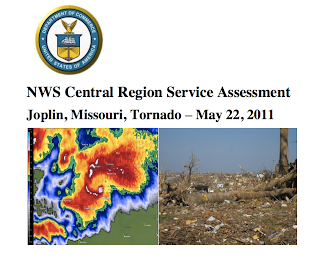NWS Report on the Joplin Tornado
After major weather-related disasters, the National Weather Service conducts a “Service Assessment” to understand what can be learned and what can be improved with regard to their forecasts and warnings.
The NWS just released its Joplin Service Assessment pertaining to the storm that killed 162 on May 22.
Several of their key findings include (my words in bold, assessment language in italics):
False Alarms of Severe Storms are a Real Problem
It was common in the interviews to hear residents refer to storms always blowing over and missing Joplin, or that there seemed like there was a protective bubble around Joplin, or ―there is rotation all the time, but never in Joplin…
Sounding Sirens for Severe Thunderstorm Warnings Caused Complacency
the perceived frequency of siren activation (false alarms) led an overwhelming number of participants to become desensitized or complacent to this method of warning. Many noted that they hear sirens all the time[sirens] go off for dark clouds, they are bombarded with [sirens] so often that we don‘t pay attention, the sirens have gone off so many times before, sirens are sounded even for thunderstorms, and all sirens mean is there is a little more water in the gutter.
Because People Want to “Confirm the Threat for Themselves” – the Invisible Nature of the Rain-Wrapped Tornado Misled People into Believing the Siren Was Sounding for a Severe Thunderstorm Warning.
While searching for additional information concerning the severe weather threat constitutes ―taking an action,‖ the actions many residents described taking were not the immediate life- saving measures desired with the issuance of a tornado warning. In most cases, these life-saving actions, or the decision to find shelter, were associated with additional extraordinary risk signals. This was generally achieved in different ways, including:
a. Physical observation of the environment (seeing the tornado approach).
While significant numbers of people actually did this, the approach was complicated by having a ―rain-wrapped‖ tornado that made the tornado more difficult to recognize until it was very close. There were numerous accounts of people running to shelter in their homes just as the tornado struck, despite significant advance warning of the risk.
The report confirms my recommendations that sirens should only be sounded in extraordinary circumstances (tornado) and then only in the areas directly at risk. The multicounty siren activations in areas like St Louis lead to complacency and the opposite public response from what emergency management would like.
To individuals, take shelter when the warning is issued. Don’t run outside trying to figure out the threat.





It seems Wichita has learned that lesson regarding siren-sounding, would you agree Mike? I read that some Joplin residents said sirens are tested all the time randomly & they weren't clear when that was happening vs. a real threat. I don't remember our testing ever happening other than Mondays at noon, & anyone who's lived in Wichita for a while knows that. Also, if I'm not mistaken the siren testing will not happen if there is unstable weather during that time, just to eliminate further confusion. Also, don't recall sirens sounding for anything less than tornado warnings.
ReplyDeleteI know people here still have a less than vigilant response to warnings at times, but I'm thinking the increased specificity in warning areas (not the whole county) will increase compliance.
Hi Jan,
ReplyDeleteWichita's sirens are tested every Monday at noon. The tests do occur if it is cloudy, I do not know whether they are called off if there is a threat of severe weather.
I give Wichita credit: We only sound the sirens for tornado warnings. And, starting in 2012 if all goes well, they will only sound the sirens in the path of the tornado, using the NWS polygon warnings.
So, big improvements coming to our outdoor warning system.
Thanks for the comment.
Mike
Again, St Louis does not have a multicounty activation system. The majority of counties in the St Louis region do not even have a siren system.
ReplyDeleteSt Louis County activated their sirens less than 15 times in the last 12 months -including- monthly tests. They activate when a tornado warning is issued or when Skywarn informs them of a direct path tornado threat.
@7:17am. Have they recently changed their policy?
ReplyDeleteThe sirens sounded in downtown St. Louis 4 times in a single day, May 26, 2011. Adding monthly tests (assuming no other activations) would bring the total to at least 16.
I was interviewed for this report the following day: http://www.kmov.com/news/local/Could-a-mass-sounding-of-tornado-sirens-do-more-harm-than-good-122759099.html
Note the St. Louis Co. representative defended their siren over warning.
Mike,
ReplyDeleteThanks for posting this. I have a few immediate thoughts.
I like how the authors used the word "perceived" in front of the obvious over- activation of the sirens and the desensitization of the public in Joplin.
Also, the jabs at the NWSTSA for having their 88d running in volume scanning strategy that didn't help NWSSGF? Did the authors not realize that Tulsa was dealing with tornadic storms in their own CWA?
This storm would undoubtedly killed many, many people, but let's face it, the number of false alarm tornado warnings for non-supercell tornadoes from NWSSGF most likely contributed to the apathy.
Am just watching our Sedgwick County emergency manager on City7 tv going over severe weather preparedness. He stated the sirens are not run for testing if there are clouds; tests are only performed if sky is clear. Honestly, I haven't paid enough attention to notice for sure, but just thought I'd post what I just heard. Maybe a policy, but not a practice? Glad to see the questions being answered though and some proactive education, but don't know how many people actually watch City7. As always, thanks for all the info, Mike.
ReplyDelete